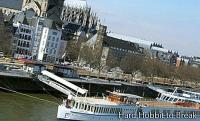
The municipality of Cervera It is the capital of the region of La Segarra and is located in the province of Lleida. Its beginnings as a population go back to the century VI B.C.., although the documentation that exists in this regard dates from the 11th century AD.
Your old structure it had to be closed, using the exterior walls of the houses as the city wall. Strolling through the streets of Sabater (Zapatero) and les Bruixes (de las Brujas), we can see the vestiges of this curious structure.
Places of interest
The University of Cervera - It is one of the most important buildings in the century XVIII in Catalonia, built from a decree of Felipe V, in the year 1717. Its structure is neoclassical although baroque in many decorative elements.
Sant Antoni Church - Although the current building is in a neoclassical style, you can see remains of the old buildings from their origin medieval. It was conceived as hospital in the thirteenth century to cure the fire evil, a disease caused by a bread fungus.
The Berenguer de Castelltort hospital - It dates from the same time as the university and the similarities of both are evidenced, mainly, in the cloister of the pilgrims.
Ramparts - Until the fourteenth century, the same houses that only had doors on inner streets, closed the city. Later, during the reign of Pere the Cerimoniós (Pedro the Ceremonious), the walls that still surround the city on the eastern side were erected.

The main street - It preserves some of the porches or arches that start from the Main Square.
Sant Agustí Church - Located on the main street, it stands out for a magnificent rose window that presides over the façade, with a fundamental structure gothic, despite having been rebuilt.
Johan House - Across the same street, this house stands out century XVI, with a magnificent portal, windows with heraldic symbols and, under the roof wing, an interesting porch in the attic of the house.
Architectural ensemble of the Jesus company - Seat of the old church of Sant Bernat, where the Catalan Courts met, in the years 1358 and 1359, to agree on the creation of the Generalitat of Catalunya and where the marriage covenants were signed between Fernando de Aragón and Isabel de Castilla. Inside the philosopher's cell is preserved Jaume Balmes with its bedroom, the library of the time, a small oratory and the Sant Nicolau processional cross, a masterpiece of Catalan goldsmithing.

La Paeria or town hall - Dates from century XVIII and stands out significantly for the corbels located under the balconies that represent the market, the bodily senses and the prison. Inside it preserves an ice well from the 16th-17th centuries, the Gothic chapel of Santa Agueda, the Kings' Hall and the Rococo-style session room.

Church of Santa Maria - In style Catalan Gothic, the church preserves the Romanesque images of the Virgin and Child.

The Coven of Cervera
In addition to standing out for its remarkable architectural heritage, Cervera has celebrated the famous Coven for more than thirty years, the last weekend of August. In this celebration of historical connotations, its centuries-old streets are filled with shows, music, magic and esotericism so that visitors can enjoy three fun days with their nights full of mystery.
Amstrad Eterno 2018 Mesa redonda de Dinamic (April 2024)
- heritage
- 1,230
















